Coffee affected by Red Blister Disease
Farmers in Munkono district recently reached out to National Union of Coffee Agribusinesses and Farm Enterprises (NUCAFE) over a possible outbreak of ‘a strange’ and devastating coffee disease.
NUCAFE is the umbrella body of coffee farmers across the country.
According to farmers, the disease presents with small-red and slightly raised spots that appear on both the green and ripening coffee berries that later enlarge and join forming unsightly red blisters on them.
The disease that is now wide spread in Mukono and other parts of Central region destroys the embryonic part of the coffee cherries, making them to ripen before they are due and eventually affecting the quality and weight on harvest.
To save farmers from losses, NUCAFE in collaboration with National Coffee Research Institute (NaCORI) based in Kituza, Mukono on Wednesday August19, 2020 sent a team of experts to Gobero village, Mpata Sub-County in Mukono district to diagnose the problem.
John Robert Ekwaru, a lab technician at NaCORI, who led the team, observed that farmers in Mukono are suffering from Red Blister Disease, a fungal disease.
He said the diseases is not new, but it is fast-becoming a problem. He explained that it starts from selection of planting materials.
“Coffee picked anyhow and anywhere -maybe from the forest or a friend is susceptible to this disease,” Ekwaru said, adding: “Farmers should source coffee planting materials from nurseries recommended by Uganda Coffee Development Authority (UCDA).”
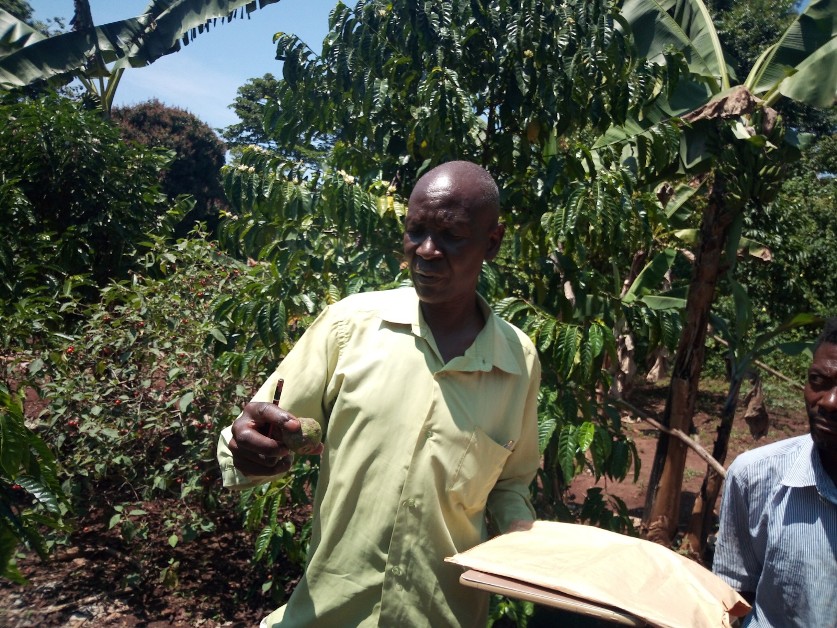
He noted that once you see coffee seedlings in a nursery bed with brown eye like spots on leaves, it is a sign that in future they could suffer from Red Blister Disease. He adds that it is highly pronounced in Robusta seedlings.
“The predisposing factor (for Red Blister Disease) is poor soils. Some varieties are more susceptible to the disease than others,” he said, adding: “The soils are tired. After harvesting, it is important to replenish the soil with organic manure to replace lost nutrients.”
He explained that boosting soil fertility helps coffee plants to keep well saturated with nutrients that support them to develop some resistance against diseases.
“I want to emphasize that the magic bullet is to use manure (cow dung) or artificial fertilizers if you can. Manure acts as a buffer and helps to balance the soil,” he said, adding: “When you put a lot of fertilizers without soil testing, you will get problems; too much of them make the soil acidic.”
He also recommends mulching to boost soil fertility and plant health.
He added that diseases can easily devastate Robusta coffee because it cross pollinates unlike Arabica that self-pollinates.
“There’s no fungicide right now for Red Blister Disease. Therefore, the long lasting solution is to plant quality materials, apply manure and mulch. You will see miracles because the big factor is poor soils,” he said.
Coffee Berry Borer
Ekwaru also observed that some coffee trees were suffering from Coffee Berry Borer. These are tiny black beetles that burrow inside coffee cherries. They are very difficult to manage with insecticides because they are protected by the cherries.
Ekwaru said that the insects “have been here for long.” Research shows that they date back to the 16th century.
In crops affected by coffee borer beetles, yields are reduced because young bored cherries may fall prematurely and all harvested bored cherries are of lower weight.
Coffee berry borer damage also affects the sensory qualities of the coffee and this reduces the commercial value of the crop. If damage is significant, it can cause the cup to taste bitter, tarry, or fermented.
Ekwaru notes that the best way to handle them is through sanitation; keeping the plantation weed free and pruning at the right time.
He also encourages farmers to pick the affected fallen coffee cherries and bury or burn them.
He adds that after harvest season, all the dry coffee clusters should be removed.

Coffee Twig Borer
As one moves around Mukono coffee farmers, it is clear that the Black Coffee Twig Borer (BCTB) is still a big threat to Uganda’s coffee industry.
This problem is widespread across the country.
Female black twig borers construct an entry hole into the heartwood of coffee twigs and make galleries that are inoculated with an ambrosia fungus. This survival activity cuts off nutrient uptake to the twig, promptly killing the most precious part that carries coffee beans.
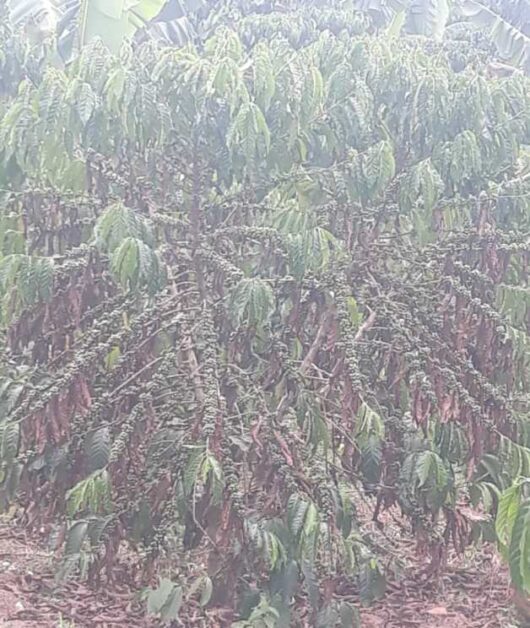
The adult female bore is deadly because it lays eggs which undergo different stages to multiply. More new adult females fly to other twigs and other plants to infest them. After very many twigs are infested on a single plant, it totally dries.
Asked how to control the Coffee Twig Borer, Ekwaru said like weeds, one method can’t effectively control Twig borers. It must be an integrated approach.
“Sanitation is key; prune off unwanted stems and branches. It is also important to remove dry and affected clusters,” he said, adding: “when pruning, start with the cleanest part/less affected area to avoid spread of diseases like Coffee Wilt Disease.”
Farmers are also encouraged to disinfect materials used to cut off the twigs or unwanted branches. A farmer can use ethanol (alcohol) to disinfect the cutting materials.
He added that the beetles start by testing the soft steams (mostly unwanted suckers) before spreading.
The other alternative is to use ethanol (alcohol) – baited traps to capture the marauding adult female BCTB, he said.
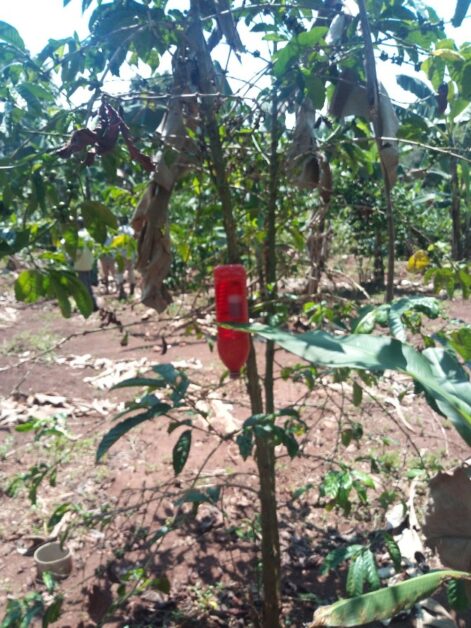
He added that shade trees should also be pruned and well spaced in the plantation because they are sometimes a breeding ground for the devastating pests.
The last option which is a bit expensive according to Ekwaru is spraying coffee trees with Imax (Imidacloprid) at 4mls per litre mixed with ORIUS (Tebucozanole) at 6m/s per litre.
“When inside, the pests feed on fungus and if you don’t use a fungicide, then eggs will hatch and young ones will feed on fungus and grow,” he said.
He emphasized the importance of healthy soils, noting that ‘strong and marvelous’ trees resist diseases and pests.
“When the soils no longer have enough nutrients for the plant, it makes them weak to withstand the diseases and pests,” he emphasized.
It is also important to note that BCTB has a host range of over 225 plant species worldwide and 48 confirmed plant species in Uganda including tea, cocoa and several ornamentals, vegetables and trees (forest, shade trees and shrub) species.
Coffee Wilt Disease
Coffee Wilt Disease (CWD) that is caused by a fungus is still present though not damaging as it were in 1990s and early 2000.
The disease blocks water and sap circulation, causing leaves to fall, branches to die, and cherries to appear ripe prematurely.
Ekwaru encourages farmers to uproot the affected coffee trees as soon as possible and burn them.
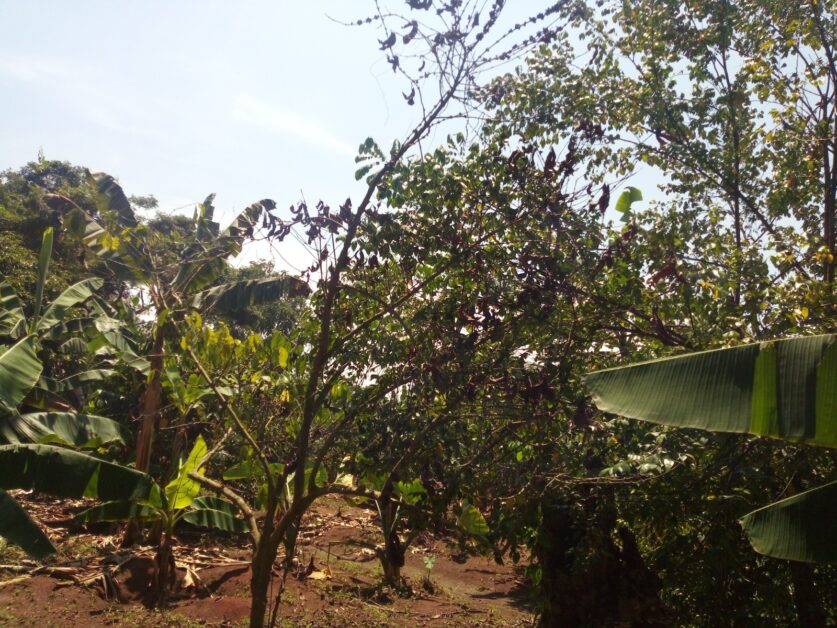
“Apart from boosting soil fertility, uprooting and burning the affected trees is the most effective method of controlling CWD,” he said.
Coffee Leaf Rust
This fungus is a worldwide problem for coffee producers. The disease presents as an orange rust-like dust on the underside of the coffee leaves. It is a cyclical condition that causes defoliation, just like coffee leaf miners. Wind and rain spread coffee leaf rust spores, which thrive at around 70°F/21°C.
Although the disease is most prevalent in Arabica grown in the warm, humid conditions of low altitudes, the disease has started attacking Robusta coffee.
Because it restricts the growth of new stems, coffee leaf rust has an impact on the next year’s crop as well as significantly reducing yield in the current year.
Plants affected by coffee leaf rust are unable to ripen fully and if they do fruit, will produce light beans that taste astringent.
This can also be fought through planting quality plantlets/seedlings and improving the health of plants.
Quoting UCDA figures, Ekwaru said Uganda loses 20% of the national coffee output to Coffee Twig Borer and Coffee Berry Borer.


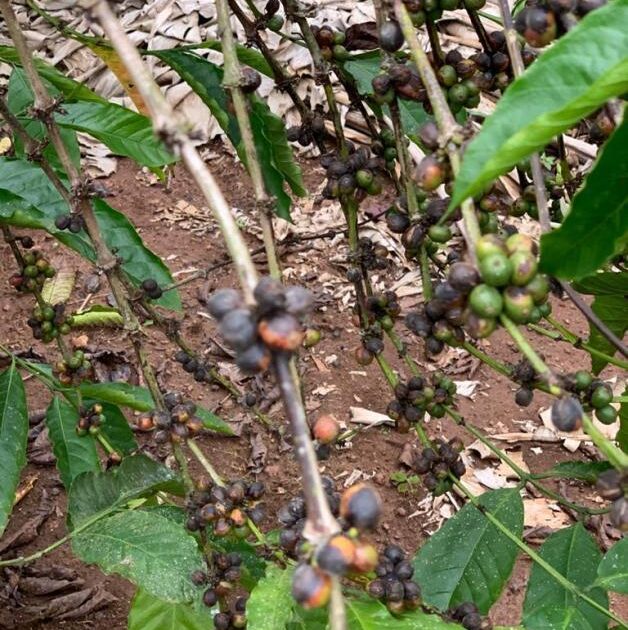




Hello thanks for the information, I work as certification officer at Balandiza kimeze Bukulula farmers cooperative society limited.
Our farmers were so attacked by coffee red blister disease.
So we need to get in touch.
Thanks
Thank you for the information. However I want to know if garden has been severely affected by the coffee red blister, can it recover by improving the soils through organic (cow dung) and inorganic fertilzers or one has to cut down and plant afresh
Thanks for the information
Very educative
I thank you for the initiative taken to enlighten us on the diseases affecting coffee. Am humbled